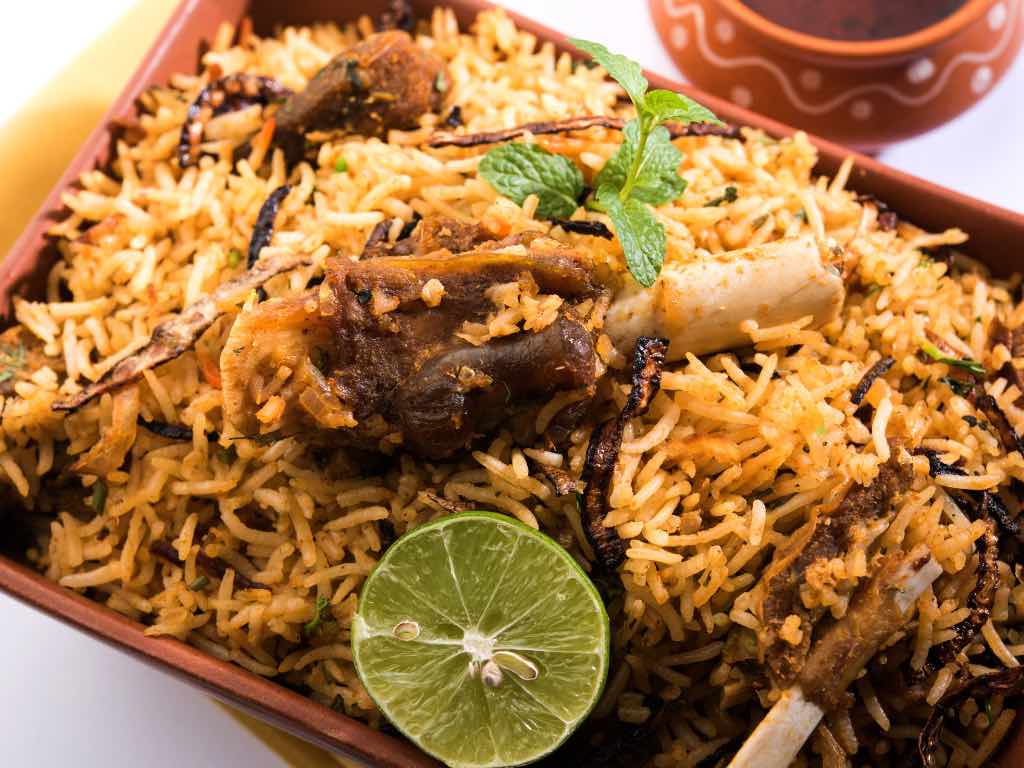
Exploring the Flavors of Goat Biryani: Culinary Masterpiece
|
|
Time to read 5 min
Welcome to One Stop Halal!
Written by: Samir P.
|
|
Time to read 5 min
Biryani, a dish synonymous with celebration and indulgence, has a special place in the culinary traditions of South Asia. Among the many varieties, Goat Biryani stands out for its rich flavors and succulent meat. This article explores the origins, ingredients, cooking techniques, and cultural significance of Goat Biryani, providing a comprehensive guide to this beloved dish.
Biryani's roots trace back to the Indian subcontinent, influenced by Persian and Mughal cuisines. The word "biryani" comes from the Persian word "birian," which means "fried before cooking." It was originally a dish of rice and meat combined with aromatic spices and herbs, slow-cooked to perfection. Over centuries, biryani has evolved into numerous regional variations, each with unique ingredients and cooking methods.
Goat Biryani, also known as Mutton Biryani, is a popular variation where tender pieces of goat meat are marinated and cooked with basmati rice, spices, and herbs. The choice of goat meat adds a distinct flavor, making it a favorite among many biryani enthusiasts. The dish is known for its rich, layered texture and aromatic profile, which comes from the blend of spices and the slow-cooking technique.
The key to a delicious Goat Biryani Recipe lies in the quality and selection of ingredients. Here's a breakdown of the essential components:
Preparing Goat Dum Biryani involves several steps, each crucial for achieving the perfect balance of flavors and textures.
The first step is to marinate the goat meat. A typical marinade includes yogurt, ginger-garlic paste, and spices such as turmeric, chili powder, garam masala, and salt. Marinating for at least 2-3 hours, preferably overnight, allows the meat to absorb the flavors and become tender.
The rice is parboiled separately from the meat. It is essential to cook the rice to 70-80% doneness, as it will continue to cook when layered with the meat. To infuse the rice with flavor, add whole spices like bay leaves, cardamom, and cloves to the boiling water.
In a heavy-bottomed pan, sauté sliced onions in ghee or oil until golden brown. This step is crucial as it imparts a sweet, caramelized flavor. Add the marinated meat and cook until it is browned and the raw smell disappears. At this point, add chopped tomatoes, green chilies, and additional spices if needed. Cover and cook until the meat is tender.
Layering is a distinctive feature of biryani. In a large pot, spread a layer of cooked meat at the bottom, followed by a layer of parboiled rice. Sprinkle fried onions, chopped herbs, and saffron-infused milk or food color for a vibrant hue. Repeat the layers, finishing with a rice layer on top. Seal the pot with a tight-fitting lid or dough to trap the steam.
The final cooking step is "dum," a traditional technique where the layered biryani is cooked on low heat. This slow-cooking method allows the flavors to meld and the rice to absorb the essence of the meat and spices. This can be done on a stovetop, in an oven, or with hot coals on the lid. Cook for about 30-45 minutes until the rice is fully cooked and the flavors are well blended.
Goat Biryani is best enjoyed hot, garnished with fresh herbs and fried onions. It's often served with a side of cooling raita (yogurt sauce), a fresh salad, and sometimes a boiled egg or a slice of lemon. Pickles and papad (crispy lentil crackers) add a delightful crunch and contrast to the dish.
Biryani is special in South Asian culture, often the centerpiece of festive occasions and family gatherings. Its preparation is considered an art, with recipes passed down through generations. While the classic Goat Biryani is beloved, there are regional variations that offer unique twists:
Welcome to the Home of the Halal Lamb. We carry various lamb cuts that are hard to find elsewhere. We deliver to your doorstep anywhere in the United States within 1-2 business days.
Biryani Goat recipe is more than just a dish; it's an experience that embodies the rich culinary heritage of South Asia. The combination of tender goat meat, fragrant rice, and a blend of spices creates a symphony of comforting and indulgent flavors. Whether it's a festive occasion or a special family meal, Goat Biryani will surely be a crowd-pleaser.
As you make Goat Biryani, remember that the key lies in the details. Each step contributes to the final masterpiece, from selecting the right ingredients to mastering the art of layering and dum cooking. With patience and practice, you can create a dish that satisfies the taste buds and warms the heart.

© 2025 One Stop Halal, Inc.